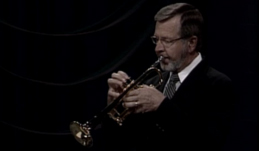Teachers' Domain - Digital Media for the Classroom and Professional Development
User: Preview



After a brief introduction to Renaissance music and the composer Palestrina, Bruce Heim, music professor at the University of Louisville, discusses key characteristics of Renaissance music. He defines and demonstrates counterpoint and homophony and discusses the development of polyphony as a reaction to the ornamentation and complexity of church music written by previous composers. The segment concludes with the Louisville Brass performing an instrumental arrangement of Palestrina's "Sicut cervus."
This resource is part of the Arts in the Renaissance collection.
Late Renaissance composer Giovanni Pierluigi was born circa 1525 near Rome in the hill town of Palestrina, which he took as part of his name. A composer of the Roman School, he is primarily known for his contributions to Roman Catholic Church music as well as his balanced and clear polyphonic compositions.
During the Medieval period, melodies were fairly simple and without decoration. The Renaissance opened the door for more complex musical compositions through the work of Palestrina and the use of imitation, when one melodic line echoes the musical theme of a previous melodic line. This imitation created some harmony. However, the melody that was being imitated remained fairly simple and plain in its structure due to concerns of the church leaders.
During the 16th and 17th centuries, the Roman Catholic Church was in the midst of the Counter Reformation, a movement to eliminate abuses and corruption within the church and also to address the Protestant Reformation. Out of this movement came the Council of Trent, established in 1545 by Pope Paul III, which had as one of its tasks the reform of church music. The church believed that polyphony was becoming too complicated, that composers were composing primarily to display their virtuosic abilities and that the text of music was too obscured by the many voices of polyphony. Things were so complicated that sometimes not only would singers be singing different texts at the same time, but the texts could be in two or more different languages.
The Council of Trent determined that church music be written in a dignified manner and that the words be intelligible. Palestrina’s polyphony was easy to understand and balanced, without a lot of adornments or unnecessary notes. The melodies are characterized by stepwise progression rather than leaps, and his use of chromatics is limited. A chromatic scale moves by half steps and includes all 12 pitches in an octave. The beauty of his motets, masses, and other compositions lies in their simplicity and clarity.
Upon leaving his post as choirmaster at the church of St. John Lateran in 1560, Palestrina became choirmaster at Santa Maria Maggiore. It was during this time that he wrote his most famous piece, the Missa Papae Marcelli, or Pope Marcellus Mass, which is an excellent example of the Counter-Reformation style. It is a model piece not based on a pre-existing melody as most of his other masses were. Legend has it that this is the piece that caused the Council of Trent to accept polyphony. While this is exaggerated, it was likely that, given his reputation, Palestrina was consulted on decisions about music. In 1566, Palestrina became the music director at the new Roman Seminary, and in 1571, he was appointed the choirmaster at the Julian Chapel in Rome, where he would stay the rest of his life. Palestrina left hundreds of compositions, including 104 masses and more than 300 motets. He died in 1594 of pleurisy.
 Loading Standards
Loading Standards